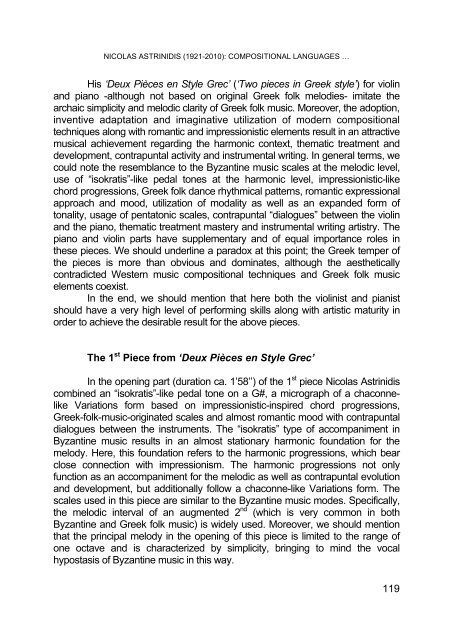musica - Studia
musica - Studia
musica - Studia
You also want an ePaper? Increase the reach of your titles
YUMPU automatically turns print PDFs into web optimized ePapers that Google loves.
NICOLAS ASTRINIDIS (1921-2010): COMPOSITIONAL LANGUAGES …<br />
His ‘Deux Pièces en Style Grec’ (‘Two pieces in Greek style’) for violin<br />
and piano -although not based on original Greek folk melodies- imitate the<br />
archaic simplicity and melodic clarity of Greek folk music. Moreover, the adoption,<br />
inventive adaptation and imaginative utilization of modern compositional<br />
techniques along with romantic and impressionistic elements result in an attractive<br />
<strong>musica</strong>l achievement regarding the harmonic context, thematic treatment and<br />
development, contrapuntal activity and instrumental writing. In general terms, we<br />
could note the resemblance to the Byzantine music scales at the melodic level,<br />
use of “isokratis”-like pedal tones at the harmonic level, impressionistic-like<br />
chord progressions, Greek folk dance rhythmical patterns, romantic expressional<br />
approach and mood, utilization of modality as well as an expanded form of<br />
tonality, usage of pentatonic scales, contrapuntal “dialogues” between the violin<br />
and the piano, thematic treatment mastery and instrumental writing artistry. The<br />
piano and violin parts have supplementary and of equal importance roles in<br />
these pieces. We should underline a paradox at this point; the Greek temper of<br />
the pieces is more than obvious and dominates, although the aesthetically<br />
contradicted Western music compositional techniques and Greek folk music<br />
elements coexist.<br />
In the end, we should mention that here both the violinist and pianist<br />
should have a very high level of performing skills along with artistic maturity in<br />
order to achieve the desirable result for the above pieces.<br />
The 1 st Piece from ‘Deux Pièces en Style Grec’<br />
In the opening part (duration ca. 1’58’’) of the 1 st piece Nicolas Astrinidis<br />
combined an “isokratis”-like pedal tone on a G#, a micrograph of a chaconnelike<br />
Variations form based on impressionistic-inspired chord progressions,<br />
Greek-folk-music-originated scales and almost romantic mood with contrapuntal<br />
dialogues between the instruments. The “isokratis” type of accompaniment in<br />
Byzantine music results in an almost stationary harmonic foundation for the<br />
melody. Here, this foundation refers to the harmonic progressions, which bear<br />
close connection with impressionism. The harmonic progressions not only<br />
function as an accompaniment for the melodic as well as contrapuntal evolution<br />
and development, but additionally follow a chaconne-like Variations form. The<br />
scales used in this piece are similar to the Byzantine music modes. Specifically,<br />
the melodic interval of an augmented 2 nd (which is very common in both<br />
Byzantine and Greek folk music) is widely used. Moreover, we should mention<br />
that the principal melody in the opening of this piece is limited to the range of<br />
one octave and is characterized by simplicity, bringing to mind the vocal<br />
hypostasis of Byzantine music in this way.<br />
119

















